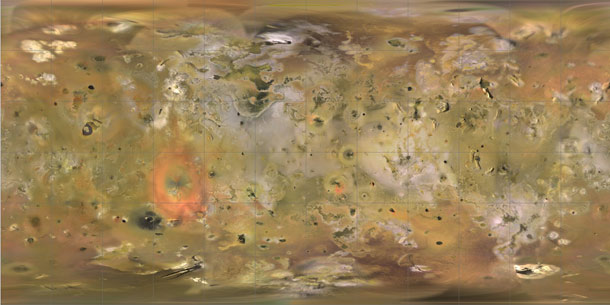Create a free profile to get unlimited access to exclusive videos, sweepstakes, and more!
Lost on the pizza moon

Speaking of Io... Oh man, do I remember that time I was cavorting around on that little moon of Jupiter, and took a left instead of a right at the flank of Tvashtar Paterae! That was so embarrassing. If only I'd had this really cool global geological map of Io's surface:
[Click to enjovianate.]
This map was made by combining data from Voyagers 1 and 2 as well as high-resolution images from Galileo, which orbited Jupiter for nearly eight years starting in 1995. The map is the result of painstaking work piecing together data from the different missions.
This task was made harder by the fact that Io is the most geologically active object in the solar system, with constantly erupting volcanoes -- the surface changed significantly between the eras of Voyager and Galileo. Io is so volcanic because it's getting squeezed by tidal forces from Jupiter and the other large moons orbiting the huge planet.
The colors of Io come mostly from sulfur deposits spewed from volcanoes. The big orange ring to the lower left is the volcano Pele, for example. Prometheus is another volcano located smack on Io's equator just to the right of the map's center; Prometheus is a busy little mountain, which has essentially been erupting since it was first discovered in Voyager pictures in 1979!
I've seen Io literally hundreds of times through telescopes; it's bright enough to easily be seen next to Jupiter, and was in fact discovered by Galileo shortly after he first pointed his telescope at the planet! It's easy to forget that these are not just points of light in the sky, but actual worlds. Look at that picture again: when Galileo observed Io for the first time, we didn't have maps of Earth that were this detailed. Four centuries is a long time, and we've learned a lot, of course. That's what happened when you keep your hands on the guiding wheel of science. It's a lot harder to get lost, and just look how far it's taken us.
Image credit: U.S. Geological Survey
Related Posts:
- The Galilean Revolution, 400 years later
- Ioâs footprint on Jupiter takes the lead
- Jupiterâs moons light up aurora borealis
- New Horizons at Jupiter



























